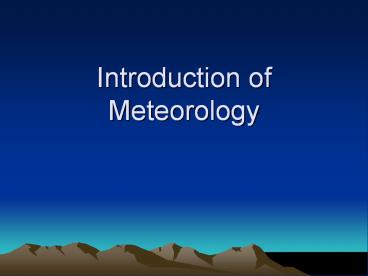Introduction of Meteorology PowerPoint PPT Presentation
Title: Introduction of Meteorology
1
Introduction of Meteorology
2
Objectives
- To describe, in your own words, what the word
meteorology means. - To describe, in your own words, what a
meteorologist is. - To describe, in your own words, what weather is.
- To describe, in your own words, what a climate.
- To describe, in your own words, the difference
between weather and climate.
3
What is Meteorology?
- It is the scientific study of all changes in the
atmosphere. This is very useful for weather
forecasting.
4
What is a meteorologist?
- A person who studies changes in the atmosphere.
This person may forecast the weather.
5
What is weather?
- The four main components which cause weather are
the Sun, the atmosphere, water vapour and the
wind. - These all work together, spreading the Suns heat
around the world and making clouds, rain and
snow. - Weather is an endless cycle of events.
6
Where does it happen?
- The atmosphere is like a giant blanket of air
around the Earth. - It is divided into layers. Weather happens in the
troposphere, the layer directly above the ground. - We will learn more about he atmosphere in lesson
2.
7
Here are the 5 major weather elements
- Air Temperature
- Wind
- Humidity
- Pressure
- Rainfall
- So why are there changes in these five elements?
8
- The scientific study of climate and weather-
Meteorology will explain why.
9
Can you name different types of weather?
10
Climate and Weather
- We will begin our study of the weather by
learning the difference between the word
weather and the word climate.
11
Weather
- Weather is what happens outside day to day based
on the seasons and other factors.
12
Climate
- Climate is the pattern of weather that occurs
over a long period of time in a particular area
or region. - Desert or arid
- Tropical
- Polar
- Forrest tundra
- Temperate
- Mountain
13
Dessert/Arid
- Arid climates can be found on every continent.
They range from hot and dry deserts that see
almost no rain to semiarid scrub land where rain
falls intermittently. Arid climates are not
suitable for most life forms. Plants and animals
that make their homes in arid climates have made
special adaptations to the environment. - Read more Characteristics of Arid Climates
eHow.com http//www.ehow.com/info_8441465_characte
ristics-arid-climates.htmlixzz1fhptx1vz
14
Tropical
- One of the classifications is that of tropical
wet climates, or rainforests. Humid tropical
climates have distinguishing characteristics
other than temperature and precipitation.
Tropical humid climates have distinct locations
and abundant animal and plant life.Read more
The Characteristics of a Humid, Tropical Climate
eHow.com http//www.ehow.com/info_8520547_charac
teristics-humid-tropical-climate.htmlixzz1fhqICV2
y
15
Polar
- Polar climates remain very cold throughout the
year with temperatures ranging between negative
70 degrees and 20 degrees Fahrenheit. Physical
characteristics of polar climates include
glaciers and thick layers of ice on the ground.
The different kinds of polar climates include
tundra climates and ice cap climates. Tundra
climates have at least one month in a year when
the average temperature is above freezing levels.
The coldest temperatures in the world are found
in Antarctica, which is an ice cap climate. - Read more What Are the Six Climate Zones?
eHow.com http//www.ehow.com/info_8160068_six-clim
ate-zones.htmlixzz1fhqYFhQu
16
Trundra
- The tundra climate is found along arctic coastal
areas. Polar and arctic air masses dominate the
tundra climate. The winter season is long and
severe. A short, mild season exists, but not a
true summer season. Moderating ocean winds keep
the temperatures from being as severe as interior
regions.
17
Forrest
- This is a continental climate with long, very
cold winters, and short, cool summers. This
climate is found in the polar air mass region.
Very cold air masses from the arctic often move
in. The temperature range is larger than any
other climate. Precipitation increases during
summer months, although annual precipitation is
still small.
18
Temperate
- Temperate climates, otherwise known as
meso-thermal climates, are cooler than
subtropical climates, but warmer than polar
climates. The moderate oceanic climate is a
sub-type of temperate climates. The regions have
fresh summers and wet winters with mild weather.
A continental moderate climate is another
sub-type of temperate climates. These regions
have hot, rainy summers and cold, dry winters. - Read more What Are the Six Climate Zones?
eHow.com http//www.ehow.com/info_8160068_six-clim
ate-zones.htmlixzz1fhqrAIba
19
Mountain
- Alpine climates are similar to tundra climates
because they are both cold and dry throughout the
entire year. The annual precipitation of alpine
climates is about 30 centimeters (about 12
inches) per year. These climates are found at the
tops of mountains, which are vacant of any trees,
other than dwarf trees. Other plants found in
alpine climates include tussock grasses, heaths
and shrubs. - Read more What Are the Six Climate Zones?
eHow.com http//www.ehow.com/info_8160068_six-clim
ate-zones.htmlixzz1fhqhrCee
20
(No Transcript)
21
Weather Journal
- Cover title and name
- First page definition (in your own words) of the
word meteorology and meteorologist. - Second page definition (in your own words) of
weather with pictures of different types of
weather. - Third page definition of climate (in your own
words) plus a picture of each different type of
climate. - Review rubric to make sure your work meets all
requirements.
22
Forecasting Project

